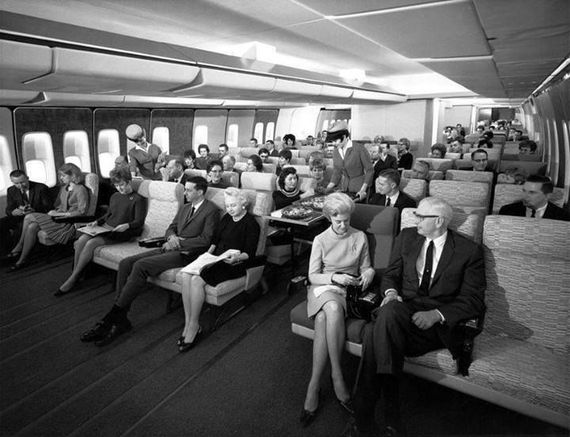
Think back to the 1960s when customer service and satisfaction were something businesses took pride in. Consider how airlines built economy class seating in a 747 in the 1960s, and then compare that vision to what economy class travellers experience today.
This image depicts the vision of Boeing's 747 economy seating by engineer Joe Sutter, Boeing's lead designer on the 747 and author of 747: Creating the World's First Jumbo Jet and Other Adventures from a Life in Aviation. It's a far cry from the air travel experience of today. Mr. Sutter and his team sought to create a luxurious experience for travelers by designing an interior that made passengers feel like they were being pampered at a high-end resort. Traveling on the 747 wasn't just a means to an end; it was an experience in and of itself.
Airlines, like many businesses in the 60s, understood the value of customer experiences as a brand differentiator. Fast forward to today and airlines promote low CO2 emissions, speed, and safety when speaking about travel and their fleets of 747s, not the experience of traveling. Somewhere along the line, airline passengers stopped being passengers and became cargo.
"Customer-Centric" is Merely a Buzzword
In the 1960s brand marketers sought to make their mark by creating experiences that resonated emotionally with the customer. Their efforts went beyond the use of the term as a buzzword, and was a true effort to create a physical environment that personified the brand's interest in the satisfaction and loyalty of the customer.
Today, brands use terms like "customer-centric" and "customer-focus" loosely. They're attempting to retrain customers to believe that factors such as speed and efficiency are the guidelines for customer satisfaction. And we're buying it.
Sadly, we've failed to notice this shift. Or we noticed and simply accepted it. We've all become accustomed to lower service levels for higher fees. Our society is driven by speed and profit. At most gas stations, we pump the gas, check the oil level, and clean the windshield ourselves, receiving less service than in the past, yet we pay more. We manage our finances through ATMs and websites, and no longer through tellers. Yet we often pay the same or more service fees to the bank.
The Customer Experience Caste System
I'm not suggesting that brands which continue to provide a superior customer experience no longer exist. However, superior customer experiences have become more hierarchical in nature, creating a caste system of sorts. Status, both financial and social, has become a dividing line for how brands design and offer superior customer experiences.
Airlines have created multiple classes of seats today, offering both First Class and Business Class. Within the economy cabin there are regular economy seats as well as "preferred seating" or "economy-comfort seating" that provide early boarding privileges and slightly extra legroom for those who can afford it. Airlines are creating brand experience that revolve around price, not experience. They offer the lowest possible price by stripping all the fun, prestige, and service that was once associated with air travel and offer a cafeteria-style menu of extras that just serves to further infuriate patrons.
The idea of skewing superior customer experiences towards those with stronger balance sheets seems intuitive at first pass. Customers with more money, those who purchase first class seats, may drive greater short-term profits. However, as the divide between the "haves" and "have-nots" in our society widens, businesses may be chasing the wrong group.
A Case For The Lower Class
When President Barack Obama was campaigning against Hillary Clinton for the Democratic Party's presidential nomination in 2008, Ms. Clinton focused on fundraising from her well-connected and wealthy Rolodex. Most of her personal contributors contributed the maximum personal donation allowed ($2,300) whereas Mr. Obama, who was less connected at the time, received a good portion of his donations from those contributing less than $200 each. It's well-documented that Obama out-fundraised Clinton by a large margin, in part, because of the strategy of appealing to the larger base.
Of course, social media enabled this strategy to work; however, the lesson remains: In today's economy, if you can capture the loyalty of those with less disposable cash, due to their sheer numbers, the net result can be greater.
Of course, such as a strategy requires a corporate culture that rewards long-term planning and gives more leeway to customer experience strategists and less to shareholders seeking bigger and bigger quarterly returns. The fact is that focusing on an improved customer experience often pits the marketing team at odds with the bottom-line needs of the business and its stakeholders. Yet, when done right, the payoff can be huge.
Who Will Have The Courage?
In the face of the furor over the poor quality of the service aboard airlines, narrower seats, less leg room, and higher fees, imagine if an airline chose to proactively improve the flying experience for the vast majority of customers who could not afford to purchase first class tickets? Instead of re-branding an airline with new paint, logos, and viral social media videos, what if it created an experience that resembles Mr. Sutter's original vision of economy seating in the 747 wide-body aircraft? Re-introduced luxury in air travel without significantly increasing fees?
Sure, the company would take an immediate hit on the bottom line, but imagine the market share that could be captured. Lower profit on each flight might very well be offset by an expanded fleet, more flights, and more routes. More importantly, the loyalty and good will that would be earned from re-engineering the customer experience, so that passengers were once again valuable customers deserving of respect -- instead of cargo -- would drive up customer lifetime value and keep shareholders happy.
But this takes courage. Which airline will dare to have that courage and know-how?
Which are your favorite airlines -- and why? Join the conversation in the comments below.
